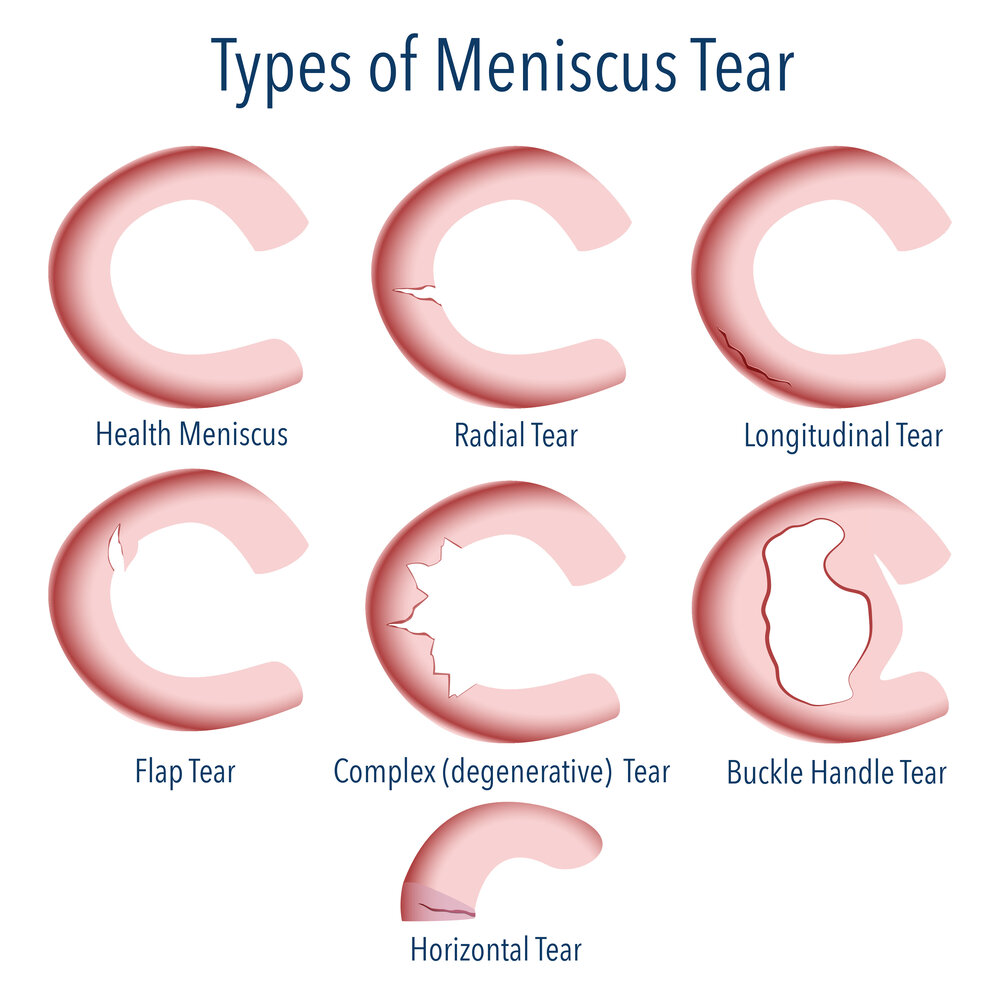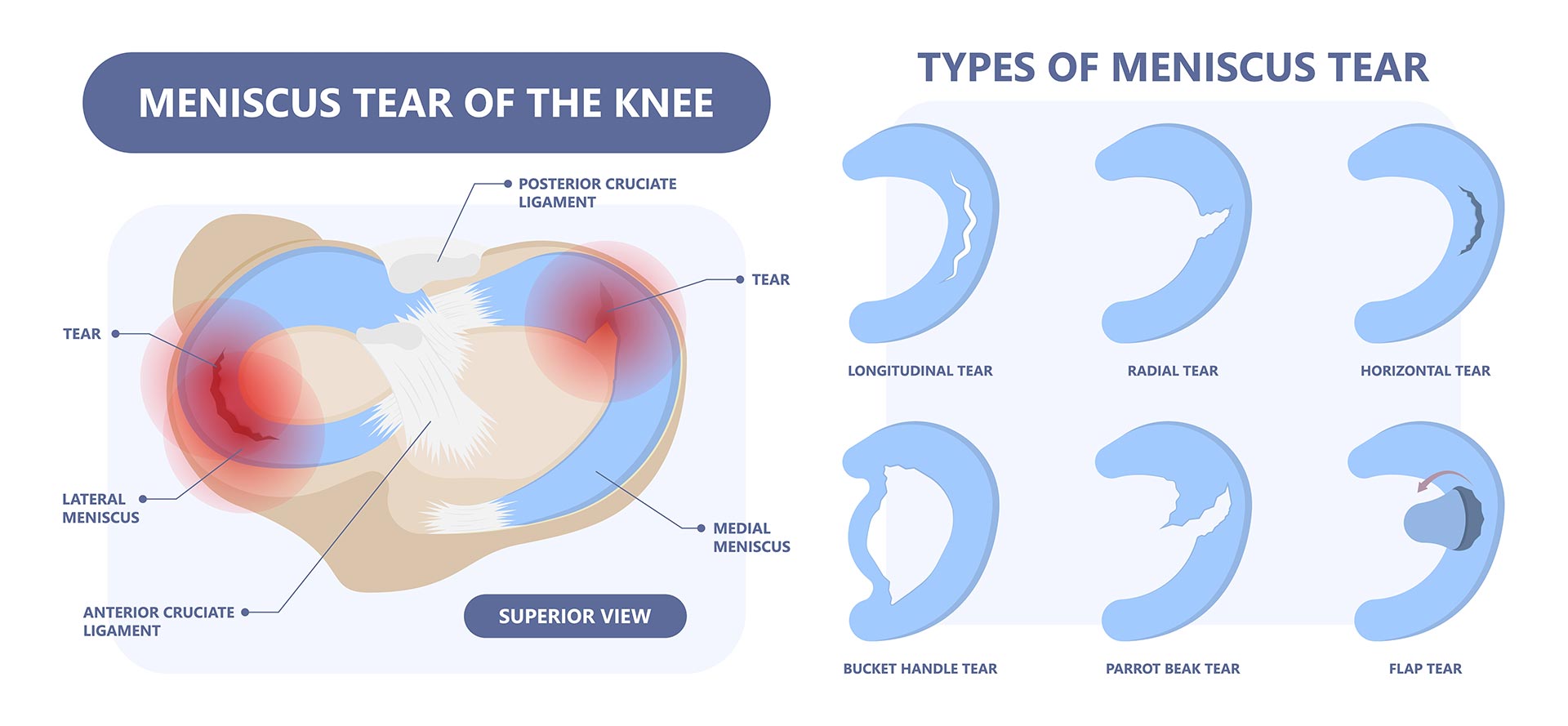Understanding the Torn Meniscus

The meniscus is a C-shaped piece of cartilage that acts as a shock absorber between the thighbone (femur) and the shinbone (tibia) in your knee joint. It helps distribute weight evenly, prevents friction between the bones, and provides stability to the knee.
Anatomy and Function of the Meniscus
The meniscus is made of tough, rubbery cartilage that is less stiff than bone but stronger than tendons and ligaments. It has two parts: the medial meniscus, on the inside of the knee, and the lateral meniscus, on the outside of the knee. Both menisci are attached to the ligaments that surround the knee joint.
Types of Meniscus Tears
Meniscus tears can be classified into different types based on the location and severity of the tear. Some common types of meniscus tears include:
- Horizontal Tear: A tear that runs horizontally across the meniscus.
- Vertical Tear: A tear that runs vertically down the meniscus.
- Radial Tear: A tear that starts at the outer edge of the meniscus and extends towards the center.
- Bucket-Handle Tear: A large, vertical tear that detaches a portion of the meniscus, resembling a bucket handle.
Causes of a Torn Meniscus
A torn meniscus can occur due to a sudden twisting or forceful impact on the knee. Common causes include:
- Sports Injuries: Activities that involve twisting, pivoting, or sudden changes in direction, such as football, basketball, and skiing.
- Falls: A direct fall on the knee can cause a meniscus tear.
- Degenerative Changes: As we age, the meniscus can become thinner and weaker, making it more susceptible to tears.
Symptoms of a Torn Meniscus
The symptoms of a torn meniscus can vary depending on the severity of the tear. Some common symptoms include:
- Pain: Sharp pain in the knee, especially during twisting or bending movements.
- Swelling: Swelling around the knee joint.
- Stiffness: Difficulty straightening or bending the knee.
- Locking: The knee may lock in a bent position, making it difficult to straighten.
- Clicking or Popping: A clicking or popping sensation in the knee joint.
Diagnosis and Treatment Options: Torn Meniscus

Once you’ve understood what a torn meniscus is, the next step is to figure out how to deal with it. This involves getting a proper diagnosis and then exploring the different treatment options available.
Diagnosing a Torn Meniscus
The process of diagnosing a torn meniscus usually involves a combination of physical examination, imaging tests, and sometimes, a review of your medical history.
- Physical Examination: Your doctor will examine your knee, checking for tenderness, swelling, pain, and instability. They will also test your range of motion and assess how well you can walk and bear weight.
- Imaging Tests:
- MRI (Magnetic Resonance Imaging): This is the gold standard for diagnosing a torn meniscus. It provides detailed images of the soft tissues in your knee, including the meniscus, allowing your doctor to see the extent and location of the tear.
- X-ray: While an X-ray won’t show the meniscus directly, it can help rule out other conditions, like a fracture, and assess the alignment of your knee joint.
- Medical History: Your doctor will ask about your symptoms, how the injury occurred, and any previous knee problems you might have had.
Treatment Options for a Torn Meniscus
Treatment for a torn meniscus depends on factors like the severity of the tear, your age, activity level, and overall health. There are two main approaches: conservative and surgical.
Conservative Treatment
Conservative treatment aims to manage pain and improve function without surgery. It may involve:
- RICE (Rest, Ice, Compression, Elevation): This helps reduce swelling and inflammation.
- Pain Medications: Over-the-counter or prescription pain relievers can help manage pain.
- Physical Therapy: Exercises to strengthen the muscles around your knee, improve range of motion, and enhance stability.
- Bracing: A knee brace can provide support and stability, especially during activities.
- Weight Management: Losing weight can reduce stress on your knee joint.
Surgical Treatment
Surgery is considered when conservative treatment fails to provide relief or if the tear is severe and causing significant problems. There are two main types of surgical procedures:
- Arthroscopic Surgery: This minimally invasive procedure uses a small camera and instruments inserted through small incisions. The surgeon can repair or remove the torn portion of the meniscus.
- Repair: If the tear is in a good location with a good blood supply, the surgeon may be able to repair it by stitching it back together.
- Partial Meniscectomy: If the tear is in a poor location or has a poor blood supply, the surgeon may remove the torn portion of the meniscus. This is a common procedure, and it doesn’t necessarily weaken the knee joint, as the meniscus is designed to be resilient.
- Open Surgery: This is a more invasive procedure that is rarely performed nowadays. It is usually used for complex tears or when arthroscopic surgery is not possible.
Comparing Treatment Options
The best treatment option for you will depend on your individual situation. Here’s a comparison of the benefits and risks of each approach:
| Treatment Option | Benefits | Risks |
|---|---|---|
| Conservative Treatment |
|
|
| Surgical Treatment |
|
|
Rehabilitation After Surgery
Rehabilitation after surgery is crucial for a successful recovery. It typically involves a combination of:
- Physical Therapy: Exercises to strengthen muscles, improve range of motion, and regain stability.
- Rest: Avoiding activities that put stress on your knee.
- Ice: Applying ice to reduce swelling.
- Compression: Wearing a brace or compression bandage to support your knee.
- Elevation: Keeping your leg elevated to reduce swelling.
The rehabilitation process can take several weeks or months, depending on the type of surgery and your individual recovery. It’s important to follow your doctor’s instructions and work closely with your physical therapist to ensure a safe and successful return to activity.
Living with a Torn Meniscus

A torn meniscus is a common injury, particularly among athletes. While surgery is sometimes necessary, many people can manage their symptoms and lead active lives without it. Let’s explore the strategies for living with a torn meniscus.
Managing Pain and Discomfort
Pain management is crucial for improving your quality of life after a torn meniscus. Several strategies can help reduce pain and discomfort:
- Rest: Give your knee time to heal by avoiding activities that worsen your pain.
- Ice: Apply ice to the injured area for 15-20 minutes at a time, several times a day. This helps reduce swelling and inflammation.
- Compression: Use a compression bandage to help reduce swelling and provide support to the knee.
- Elevation: Keep your leg elevated above your heart when you are resting to help reduce swelling.
- Over-the-counter pain relievers: Medications like ibuprofen or acetaminophen can help reduce pain and inflammation.
- Physical therapy: A physical therapist can teach you exercises to strengthen your knee and improve its range of motion. These exercises are vital for recovery and preventing future injuries.
Potential Long-Term Effects
While many people fully recover from a torn meniscus, some may experience long-term effects. These can include:
- Chronic pain: Some people may continue to experience pain and stiffness in their knee, even after treatment.
- Joint instability: A torn meniscus can weaken the knee joint, making it more prone to instability. This can lead to recurrent injuries.
- Osteoarthritis: A torn meniscus can increase the risk of developing osteoarthritis in the knee joint. This is a degenerative joint disease that can cause pain, stiffness, and swelling.
Preventing Future Injuries
To prevent future injuries, it is crucial to strengthen your knee and surrounding muscles. Here are some tips:
- Warm up properly: Before any physical activity, warm up your muscles with light exercises like walking or stretching.
- Use proper form: When exercising or participating in sports, ensure you use proper form to avoid putting undue stress on your knee joint.
- Strengthen your leg muscles: Strong leg muscles help support your knee joint and reduce the risk of injury. Include exercises like squats, lunges, and calf raises in your routine.
- Stretch regularly: Stretching helps improve flexibility and range of motion, reducing the risk of injuries.
- Wear supportive footwear: Wearing appropriate footwear can help provide support and stability to your feet and ankles, reducing the risk of knee injuries.
- Maintain a healthy weight: Excess weight puts extra stress on your knee joint, increasing the risk of injury.
Types of Physical Therapy Exercises
Physical therapy is an integral part of recovering from a torn meniscus. Different types of exercises are used to strengthen your knee, improve range of motion, and reduce pain. Here’s a table comparing different types of exercises:
| Exercise Type | Description | Benefits | Examples |
|---|---|---|---|
| Range of Motion Exercises | Exercises that help improve the movement of the knee joint. | Reduce stiffness, improve flexibility, and increase mobility. | Knee flexion, knee extension, and leg swings. |
| Strengthening Exercises | Exercises that target the muscles surrounding the knee, including the quadriceps, hamstrings, and calf muscles. | Increase muscle strength and stability, reduce the risk of future injuries. | Squats, lunges, leg presses, and hamstring curls. |
| Balance Exercises | Exercises that improve your balance and coordination, reducing the risk of falls. | Increase stability and control, reduce the risk of re-injury. | Standing on one leg, walking heel-to-toe, and using a balance board. |
| Proprioceptive Exercises | Exercises that help improve your awareness of your body’s position in space. | Improve coordination and control, reduce the risk of re-injury. | Standing on an unstable surface, such as a foam pad or wobble board. |
A torn meniscus can be a setback, but it’s not the end of the game. Remember the resilience of the minnesota vikings , who have overcome countless challenges to achieve greatness. Just like they fight for every yard, you can fight for your recovery.
With dedication and a positive attitude, you can overcome this obstacle and return to your active lifestyle stronger than before.
A torn meniscus is a common injury, often impacting athletes and active individuals. The recovery process can be challenging, but seeing how other athletes have overcome similar challenges can be inspiring. For example, the jahmyr gibbs injury demonstrates the resilience and dedication required to return to peak performance.
Remember, with the right support and determination, you too can overcome this obstacle and get back to doing what you love.
